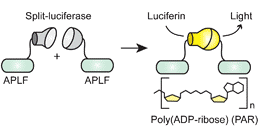Department of Chemistry
ORCID IDs
Document Type
Article
Date of this Version
2008
Abstract
Split-protein reporters have emerged as a powerful methodology for imaging biomolecular interactions which are of much interest as targets for chemical intervention. Herein we describe a systematic evaluation of split-proteins, specifically the green fluorescent protein, β-lactamase, and several luciferases, for their ability to function as reporters in completely cell-free systems to allow for the extremely rapid and sensitive determination of a wide range of biomolecular interactions without the requirement for laborious transfection, cell culture, or protein purification (12–48 h). We demonstrate that the cell-free split-luciferase system in particular is amenable for directly interrogating protein–protein, protein–DNA, and protein–RNA interactions in homogeneous assays with very high sensitivity (22–1800 fold) starting from the corresponding mRNA or DNA. Importantly, we show that the cell-free system allows for the rapid (2 h) identification of target-site specificity for protein–nucleic acid interactions and in evaluating antagonists of protein–protein and protein–peptide complexes circumventing protein purification bottlenecks. Moreover, we show that the cell-free split-protein system is adaptable for analysis of both protein–protein and protein–nucleic acid interactions in artificial cell systems comprising water-in-oil emulsions. Thus, this study provides a general and enabling methodology for the rapid interrogation of a wide variety of biomolecular interactions and their antagonists without the limitations imposed by current in vitro and in vivo approaches.
Includes Supporting Information.



Comments
Published in Journal of the American Chemical Society 130:20 (2008), pp. 6488–6497; doi: 10.1021/ja7114579 Copyright © 2008 American Chemical Society. Used by permission.